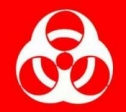To be sure you are in compliance with regulatory requirements, refer to the EHS Virtual Manual and EHS Safe Operating Procedures.

Work with potentially hazardous biological materials often involves special precautions, protocols, facilities, and surveillance requirements. Because of the potential for exposure, all employees need to be aware specific precautions used when working with biohazards. The EHS Training Needs Assessment will help you determine what training you may need. At a minimum, all employees working with biological materials need to take the Biosafety Basics training module offered by EHS. Some projects may require more advanced training as indicated in the Training Needs Assessment.
Environmental Health & Safety Link
EHS provides a number of Safe Operating Procedures (SOPs) that provide additional and useful information.
General safety guidelines to reduce the risk of infection and contamination from biohazards are:
- Prevent the formation of aerosols when working with infectious materials
- Follow sterile procedures to protect other employees and to prevent contamination
- Ensure that biosafety cabinets are certified annually.
- Test autoclaves according the EHS prescribed frequency and certification is performed annually.
- Wear Personal Protective Equipment (PPE), including lab coat, gloves, and eyewear, when working with biohazards
- Practice good handling procedures when working with biohazardous materials to prevent exposure
- Collect solid or semisolid biohazard waste in specially marked containers or bags and autoclave prior to disposal.
- Autoclave or incinerate dead animals, animal blood, fluids, tissues, organs, waste, and bedding
- Follow universal precautions when working with human blood and body tissues.
- Decontaminate work surfaces at the end of each day or after any biohazard spill using an appropriate disinfectant. (https://ehs.unl.edu/sites/unl.edu.business-and-finance.university-operations.ehs/files/media/file/s-bio-disinfectants.pdf)
- Inactivate biological hazards in mixtures containing hazardous chemicals without increasing the chemical hazards associated with the chemical; autoclaving is not recommended
- Inactivate biological hazards in mixtures containing radioactive materials using a treatment that is compatible with the radioactive material and will not volatize the radioactive component; autoclaving should only be used with the approval of the UNL Radiation Safety Office
- Incinerate or autoclave plants and all materials used in recombinant DNA studies for a sufficient period to inactivate all biological materials
- Biosafety in growth and greenhouse areas where these hazards exist requires the same microbiological practices